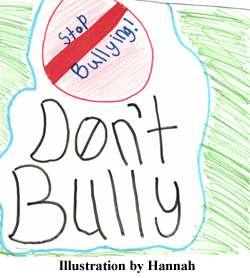 For the past few weeks, I have been writing a series on questions children ask about the most common losses in their lives, such as: death, divorce, making a move, loss of a pet. I also promised to include in this series tips for adults concerning bullying and self-esteem, which, unfortunately, kids may face on a daily basis.
For the past few weeks, I have been writing a series on questions children ask about the most common losses in their lives, such as: death, divorce, making a move, loss of a pet. I also promised to include in this series tips for adults concerning bullying and self-esteem, which, unfortunately, kids may face on a daily basis.
So, today, I’m going to take us to the subject of BULLYING — a subject that should be on the hearts of every adult in every city across the United States. I cannot do it justice in one individual post, but I hope that I make some points that will enlighten you and will spur you on to be a part of stopping bullying for children in your family and community.
Let’s begin with a story from Hadley, Massachusetts that made headline news in 2010.
Phoebe Prince, South Hadley High School’s ‘new girl’,
driven to suicide by teenage cyber bullies
Along with this headline in the local paper of Hadley, Mass., all the major networks reported the tragic story of fifteen-year Phoebe Prince committing suicide after months of abusive bullying in the school halls, as well as online, by several students. This story took on an added dimension when Phoebe’s death led to criminal charges brought against nine of her alleged tormentors.
Following this tragedy, journalists like Anderson Cooper, Dr. Phil, Oprah, Larry King, Kyra Phillips, along with their professional guests, aired segments on the effects that bullying has on young children and teens.
And then, the story of Phoebe and bullying began to fade into the background as other “breaking news” stories of the day took its place; that is until other kids commented suicide because of bullying incidents, and the news coverage started all over again.
Just exactly what does that term “Bullying” mean? The United States Department of Health and Human Services defines it in the following way:
Bullying happens when someone repeatedly hurts, scares, or is mean to another person on purpose, and the person being bullied has a hard time defending himself.
My heart still aches when I think about my own daughter who was frequently punched by a neighbor’s child when she was only 4 years old. Not wanting to make waves, I did not discuss it with the parents; I just tried to keep her safe when she was playing with him. She was also called rude names by “so-called friends” when she was a teenage, which I encouraged her to just ignore. When she reached adulthood, she confessed to me that the names she was called from her close friends still haunted her.
My daughter’s story and the way I handled it is not uncommon. I fell into the trap that so many adults do by saying: “Kids will be kids.” Yes, certain forms of teasing or children playing tag in a playful way is a part of growing up and having fun. But, things that are done to another person to hurt, harm, embarrass, humiliate, and make their life miserable, should not be passed off as a part of growing up. Everyone, especially kids, has the right to feel safe and be respected.
I also fell into another common trap that keeps adults from being pro-active in stopping bullying and that is: not recognizing the signs of bullying.
When we as parents, grandparents, school officials, children church pastors, fall into these traps, we are not hearing a child’s cry for help. When their voices are not heard, a message is being sent to lonely frustrated kids that they might as well suffer in silence. Martin Luther King, Jr. said it so well: “In the end, we will remember not the words of our enemies, but the silence of our friends.”
So, after a lot of research on the subject, I want to pass along to you ways to help you recognize bullying, so that we all can work together to put a stop to bullying in the lives of children in our families and community before something tragic happens.
Bullying occurs in four different ways:
- Physical Bullying: Hurts the body
- Verbal Bulling: Talking about or to someone in a hurtful way.
- Emotional Bullying: Plays on the mind and hurts inside
- Cyber Bullying: Hurting someone through the use of technology.
Notice, in cyber bullying, the bully’s territory has expanded and can reach directly into the comforts of your home, the one place a child is supposed to take refuge from the outside world. Not only has the bully’s territory expanded into your home, but it can reach to higher levels of harassment because the methods he uses are done in secret, thus freeing him from punishment for such unruly behavior.
While cyber bullying is more prevalent in teenagers, it is also happening in younger children’s lives. Research shows that, in most cases, it is someone your child knows, and perhaps has innocently passed his cell phone number or password on to a so-called friend.
So, what’s a parent to do, or I should say “what are the adults in a child’s life to do as a team effort to combat one of the pitfalls that exists in each of these four areas of bullying?”
The best defense against all forms of bullying is a strong offense, which involves 2 key steps.
1. Education: As with most things, education is the beginning of tackling any problem. Use the Internet to your advantage and educate yourself to more about bullying at different age levels, as well as the emotional damage that it can cause. One site which has been a service to the community for years about this subject is Health Resources and Services Administration, which is a government agency dedicated to educating the public on anti-bullying.
2. Get Involved: How can you get involved? The home page for the above site offers ideas which parents, or any interested adult, can present to schools and other organizations within their community to promote bully awareness, and ways to stop it.
I conclude with the words of Jesus in the story of the good Samaritan, found in Luke 10. In this story, Jesus told of a man who had been attacked by robbers who beat him, took his money, stripped him of his clothes, and left him beside the road to die. The first two people who came along saw the man lying there, but continued on their way. Finally a third man came along, and was kind enough to help him. Jesus ended the story by saying:
“Now, you go and do the same for someone.”
Join Hannah and me right here next week as we talk about Self-Esteem.













